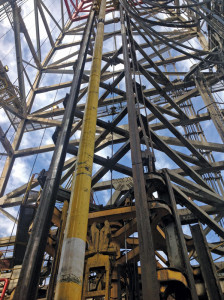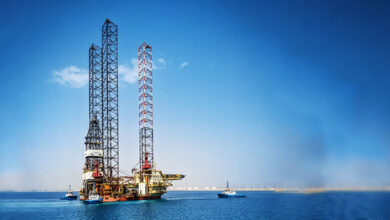Expandable liner gets deepwater well to TD past 3 sand zones
Hydraulically balanced hanger system creates larger bypass area for enhanced circulation conditions, lower ECD

By Maurilio Solano and Luis Mario Rodriguez, Baker Hughes
Deep and ultra-deepwater exploration activities continue to set records as new wells are drilled in deeper waters and in more complex reservoirs. At the same time, the geographic footprint for this activity is expanding, from the established regions of the US Gulf of Mexico, Brazil and West Africa to less-traditional areas, including East Africa, Australia, New Zealand and the Eastern Mediterranean. While each of these regions presents its own set of technical, environmental and economic challenges, many of them share common obstacles around lost circulation.
The presence of low fracture gradients, narrow drilling windows, tight casing and hole clearances, and changes to a drilling mud’s rheology due to changing water temperatures all contribute to lost circulation. Industry estimates suggest that lost-circulation events account for as much as 40% of the $1 billion in NPT costs accrued in the Gulf of Mexico.
Reaching the target
To facilitate completions in deepwater wells in which downhole systems need to safely navigate through lost-circulation trouble zones, Baker Hughes developed the TORXS expandable liner hanger system. It was designed to improve circulation and cementing operations in challenging applications, including high-pressure wells with depleted or lost-circulation zones that require a larger bypass area.
The TORXS creates a bypass area that is up to 40% larger than other expandable liner hangers and conventional liner equipment. This improves circulation conditions because it creates lower equivalent circulating density (ECD) and less pressure on the annular area.

The one-trip hydraulically balanced hanger system provides high torque capability for reaming or drilling and the ability to rotate more than 100 RPM. While conventional liner systems reach depths where they must be rotated and reciprocated to go deeper, this expandable hanger system continues rotating at high torque rates. The tool also has a smaller OD, allowing it to be run faster in tight-clearance liners in combination with smart flow diverters without fear of breaking down sensitive formations or getting hung up on ledges or tight turns.
The system is hydraulically balanced to reduce the risk of prematurely setting the hanger, and it withstands up to 10,000 psi and 12 bbl/min while running in hole.
A cleaner wellbore lowers the risk of stuck pipe, the need to drill sidetracks and, in a worst-case scenario, the need to abandon the well. A clean wellbore also increases the likelihood of a good cement job.
The system provides high burst and collapse ratings and offers advanced hanging capacity – up to 1.2 million lb for the 11 ¾-in. size. It also features the ZX seal element, which provides V0-rated sealing capabilities.
The expandable system can be run and installed conventionally, without the need for a high-pressure plug bump to activate the hanger or packer or to release the running tool. All hydraulic activations, including tool release, are achieved with pressure acting on a positive seal in the running tool. Once the system reaches setting depth, a ball is dropped from surface and lands on an extrudable ball seat in the running tool. Applied pressure then actuates the hydraulic anchor, along with the swage mechanism on the running tool. This causes the hanger body and slips to expand outward such that they make permanent contact with the casing string.
This activation method allows the hanger to be set before the cement is displaced. Once set, circulation is again established, and cementing of the liner can be performed. Like a conventional liner installation, the packer is set independently after the cement is in place. This significantly lowers the risk of unintentionally cementing the setting tool in the well.
Navigating narrow zones
The system has been deployed in approximately 400 wells, from shallow straight-hole wells to deep, highly deviated, extended-reach wells in combination with screens, inflow control devices and slotted liners.The system has demonstrated the greatest benefit in close-tolerance liners that are run into formations with different zones.
One challenge of running liner into a formation with different zones is the risk of swelling of the wellbore (at higher pore pressures) around the liner, resulting in sticking. Attempting to drill through different zones in a conventional manner, by changing the weight of the mud to balance changes of the pressure gradient in each zone, frequently proves difficult and expensive.
For example, if one drills with an oil-based mud system and encounters a loss zone where the wellbore pressure is higher than the pore pressure, one not only loses large quantities of expensive mud into the formation but also runs the risk of losing tools or damaging the integrity of the formation. The operator is then faced with delays in well construction as it decides whether to do a fishing job to retrieve lost tools, drill a sidetrack or abandon the well altogether.
An operator working in the US Gulf of Mexico wished to avoid such a dilemma while drilling a well to TD and passing through three sand zones. In previous wells in the area, the operator tried conventional liner drilling methods to pass through the three sands – with low pore pressures of 2.5 psi, 4.0 psi and 10.0 psi, respectively. Trying to get the mud weight right through each zone and avoid lost-circulation problems proved an ongoing struggle that prevented the operator from reaching TD in one trip.
The first liner drilling attempt in this well was with a standard system. However, its design was not suitable for this application due to pressure balance, as well as its limited bypass area.
The operator needed to quickly deploy an alternative system to resume drilling and get the well to TD with minimal risk of losses. It decided to deploy the TORXS 5×7-in. liner hanger in the well.
Planning the right system configuration and execution in the well began with meetings between the operator’s well engineers and the service company. Led by a dedicated project manager, the team discussed the specifics of the system, including its design, method of operation and any potential limitations.
The operator shared its knowledge of the reservoir and its drilling objectives with the service company. The team then ran several modeling scenarios and simulations to determine the best drilling parameters to use in each zone.
All relevant parameters – from the anticipated rate of penetration and pump rates to the type of centralizers and drilling muds to use – were estimated and shared with the operator. The joint team of operator engineers and service company representatives were able to agree on the desired deployment plan.
The 5 x 7-in. liner was run in conjunction with the TORXS system. Because of challenges associated with drilling through different sands and concerns about passing the liner through tight spots, a 6 1/8-in. Baker Hughes EZCase casing bit was deployed. This enabled the drilling and casing of the well in a single trip for improved economics and reduced NPT. The bit incorporates a steel crown with two rows of PDC cutting structure on each blade for enhanced performance.
The extensive planning proved valuable once the system was deployed. For example, simulation results allowed the field team to clearly and accurately anticipate the top and bottom of each formation, which helped in the accurate spacing and placement of stages in the well.
The expandable liner hanger system was deployed to a measured depth of 10,585 ft as planned, after which the casing bit drilled through 615 ft of new formation. The liner was drilled with an average of 80 RPM and 5,000-lb weight on bit to a measured depth of 11,200 ft and with ROPs ranging from 2 to 25 ft/hr. Once at TD, operations were performed to set the liner hanger and release the running tool prior to performing the cement job. The entire drilling operation took approximately 39 hrs to complete.
This coordinated liner drilling operation with the casing bit helped save rig time and minimized formation damage due to mud contamination. The system accurately identified the top and bottom of the formation depths, which correlated well with the drilling plan.
The liner drilling system also helped prevent lost circulation through the smear effect caused by side load forces that pulverized the cuttings in the narrow annular space between the liner and the wellbore. These cuttings became embedded in the wellbore wall to form a natural seal that was more impermeable than a wall cake created by mud additives.
The system was able to deliver the liner to bottom and circulate mud out of the well. This resulted in a cleaner wellbore for improved cement results. Finally, the system delivered the well without the need to run a sidetrack or incur any lost time for fishing operations.
The operator is now evaluating other potential well projects for the deployment of this liner drilling solution. The service company is taking the best practices learned from this project and exploring how it could benefit other challenging well construction scenarios.
TORXS is a trademark of Baker Hughes.




